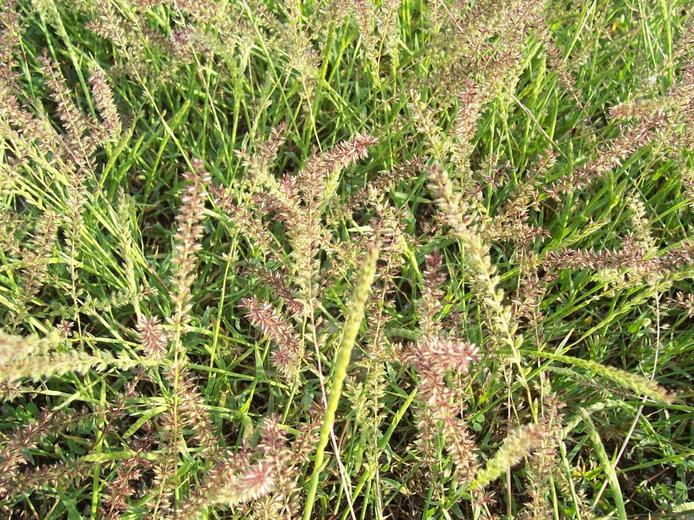Plants annual. Culms 5-40 cm. Ligules 0.5-1.3 mm; blades (0.5)1-5.5 cm long, 1.5-4 mm wide, glabrous. Panicles (1.5)2-11 cm long, 7-13 mm wide; rachises pubescent; branches 2.1-4.8 mm, pubescent, with (2)3-5 spikelets, axes extending past the distal spikelets; proximal internodes 0.5-1.8 mm, longer than second internodes. Proximal spikelets 3.8-6.6 mm; second spikelets (2.3)2.9-6.6 mm; third and fourth spikelets 0.8-4.2 mm; distal spikelets sterile. Lower glumes 0.7-1.1 mm, glabrous or minutely pubescent; upper glumes 3.8-6.6 mm, 7-veined, minutely pubescent; glume projections 6-11, in (5)6-7 rows, (0.2)0.6-1.3 mm, usually uncinate; lemmas 3.2-4 mm, sparsely pubescent on the back, midveins occasionally excurrent to 4 mm; paleas 2.3-3.1 mm; anthers 3, 0.6-0.8 mm, yellow. Caryopses 1.7-2.3 mm long, 0.6-0.8 mm wide. 2n = 40.
Tragus racemosus is native from the Mediterranean region to southwest Asia, but now grows in the United States, primarily in Cochise and Pima counties, Arizona. It was collected in Maine, Pennsylvania, New York, and North Carolina in the late nineteenth century, but does not appear to be established in these states. Reports for New Mexico and Texas appear to reflect confusion with T. berteronianus.
Common Name: stalked bur grass
Duration: Annual
Nativity: Non-Native
Lifeform: Graminoid
General: Annual grass, culms decumbent with a geniculate base and sometimes rooting at the lower nodes, 5-40 cm.
Vegetative: Nodes darkly pigmented; ligules 0.5-1.3 mm; blades 1-5 cm long, 1-4 mm wide, lower blade margins sparsely ciliate with upward-pointing hairs.
Inflorescence: Panicles 2-11 cm long, 7-13 mm wide; branches pubescent, with 3-5 spikelets, distal spikelets sterile. Spikelets 4-5 mm long; lower glumes glabrous or minutely pubescent; upper glumes 7-veined, with hooked spinelike projections; lemmas sparsely pubescent on the back, midveins occasionally excurrent to 4 mm; anthers yellow. Caryopses 2 mm long, <1 mm wide
Ecology: Found in sand and gravel substrate in our area, along roadsides and in washes, 2,000- 6,000 ft (610-1829 m). Flowers July-Sept.
Distribution: Tragus racemosus is native from the Mediterranean region to southwest Asia, and is introduced to the US, primarily in Cochise and Pima counties, AZ. It was collected in Maine, Pennsylvania, New York, and North Carolina in the late nineteenth century, but
Notes: The genus Tragus has seven species, all of which are native to the tropics and subtropics of the Eastern Hemisphere; four have been introduced into North America. The genus is easily recognized by the spinelike projections on the upper glumes. T. racemosus is distinguished from T. berteronianus by its looser inflorescence, which tends to be interrupted (has gaps between the florets) toward the bottom and larger spikelets (4-5 mm). T. berteronianus has a tight, cylindrical inflorescence with smaller (2-3 mm) spikelets. According to Flora Neomexicana (Allred and Ivey, 2012), T. racemosus has been reported but not confirmed to be present in New Mexico.
Ethnobotany: unknown
Etymology: Tragus from the Greek tragos, he-goat; racemosus refers to the raceme structure of the inflorescence.
Synonyms: Cenchrus racemosus, Nazia racemosa, Lappago racemosa
Editor: AHazelton 2015










